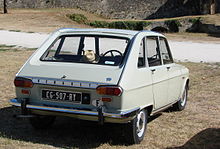Station wagon

In the EC vehicle classes , a station wagon refers to the M1 AC body type, i.e. closed passenger vehicles with an enlarged interior space at the rear. It originally comprised the classic station wagon . For a few years now, various vehicles with hatchbacks and tailgates that allow access to the interior of the vehicle have also been classified in this type of construction, for example the VW Golf . It was previously classified as an M1 AB ( hatchback sedan ).
In particular, this term is restricted to the second type, it represents a hybrid form of sedan and station wagon .
definition
In the German version, the official definition is:
- Class M1: vehicles for passenger transport with a maximum of eight seats in addition to the driver's seat (colloquially cars and mobile homes)
- Body type AC: closed, with enlarged interior space at the rear, fixed roof and corresponding fixed pillars, with at least 4 seats in at least two rows of seats (seats in the 2nd row of seats can be folded down or removed to increase the load space), two or four doors and one with tailgate and four or more side windows
Concept development and meaning
The term was coined in the late 1960s when the first station wagons from France such as the Renault 16 (1965) appeared. In Germany the triumph of the station wagon began with the introduction of the VW Golf (1974). In the small and compact class , the estate sedans have largely replaced the sedans that were common up until the 1970s. With a few exceptions, however, they could not establish themselves in the upper middle class .
In the case of the station wagon, the tailgate is counted as an additional door in many sources in the German-speaking area, such as the station wagon, so that - depending on the number of doors - one speaks of three or five-door versions. Other sources refer to the vehicles in question as two- or four-door hatchbacks.
If a three-door hatchback was not developed from a sedan but from a coupé , it is called a station wagon coupé .
VW Golf I (1974)
Saab 9000 (1985)
Mazda 626 (1997)
Lancia Delta III (2008)
In English
In the English-speaking world, a station wagon is known as a hatchback or hatch (hatch (en.) = Flap (dt.)). As with the station wagon, the tailgate does not count as a door. One speaks of the 2 door hatchback or 4 door hatchback .
literature
- Werner Oswald : German Cars 1945–1990 . Volume 4. 1st edition. Motorbuch Verlag, Stuttgart 2001, ISBN 3-613-02131-5 , p. 459: The information relates to the glass 1004 CL and 1304 CL (1966-1967).
- Lars Döhmann: Oldtimer Catalog No. 12 . Heel Verlag, Königswinter 1998, ISBN 3-89365-629-4 , pp. 44 and 65: The information relates to the BMW 1600 touring - 2000 tii touring and the Glas 1004 CL and 1304 CL (1966–1967).
Individual evidence
- ↑ Werner Oswald describes the Renault 16 as well as the Renault 6 and the Autobianchi Primula in the Auto Modelle published in autumn 1968 , catalog 1968/69 from the Vereinigte Motor-Verlage GmbH from Stuttgart as a station wagon.
- ↑ List of manufacturers and types of motor vehicles designed and built for passenger transport with at least four wheels (class M) Status: November 2016, p. 13 ( Memento of the original from March 30, 2017 in the Internet Archive ) Info: The archive link was inserted automatically and not yet checked. Please check the original and archive link according to the instructions and then remove this notice. (pdf)
- ↑ versa.bmvit.gv.at (1967)
- ^ Eberhard Kittler: German cars since 1990 . Volume 5. 1st edition. Motorbuch Verlag, Stuttgart 2001, ISBN 3-613-02052-1 , p. 255: The information relates to the VW Golf II (1983-1991).
- ↑ a b c d e This reference serves as an example. Similar references are mentioned several times in the same source and in other sources.
- ↑ Lars Döhmann: Oldtimer Catalog No. 12 . Heel Verlag, Königswinter 1998, ISBN 3-89365-629-4 , p. 113: The information relates to the VW Passat B1 (1973–1980) and the VW Golf I (1974–1983).
- ↑ The 1976 Auto Catalog from Vereinigte Motor-Verlage GmbH & Co. KG from Stuttgart, published in autumn 1975, describes the VW Golf as a station wagon. The same applies to the 17 following editions of the car catalog from the same publisher.
- ↑ James M. Flammang, Ron Kowalke: Standard Catalog of American Cars 1976-1999 . Krause Publications, Iola WI 1999, ISBN 0-87341-755-0 , p. 221: The information relates to the Chevrolet Citation (1980).



